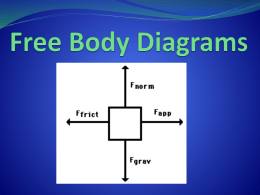

We are going to focus in friction due to contact between two surfaces. The symbol for a frictional force is a cursive "F." (The "F" you write does not need to look exactly like the one below, but it should look "cursive." No matter what math formula is used to describe the magnitude of the frictional force, they all point in the opposite direction of motion, (or the intended motion if there were no friction,) and parallel to the surfaces of contact. There are many types of frictional forces. The direction the body is moving and the other forces acting on the body do not change the normal force's direction on a free body diagram. On a free body diagram, "fbd," the normal force, "η," is ALWAYS drawn normal to the surface of contact. The floor exerts a normal force upwards against the shoe while the show exerts a normal force down against the floor.ĭrawing the normal force on an free body diagram. In order to have normal force, you must have a contact surface touching something. If you were to lean on a wall, it is the normal force that keeps you from puncturing the wall.

If you are standing on an incline the normal force would be the reaction force keeping you from sinking into the incline AND it would be perpendicular to the incline's surface. The normal force is perpendicular to the surface and is a reaction to the force(s) holding you down. The ground experiences a force pulling you down. The symbol for the normal force is the Greek letter “eta.” It look like a large lower case “n” with a tail.Ĭurrently you are sitting down or standing. The normal force keeps two surfaces from sinking into each other.

Weight is a term we use to describe the pull of gravity. Below is an example of a “body.”Ī free body diagram of the jet might look like the one below. Occasionally some simple details are added to create further clarify the situation. But physicists and engineers likes to simplify the drawing of the object by drawing a dot instead of a detailed picture. The word “body” is used to describe any object. Most importantly it shows the forces' directions without the clutter of drawing the body. It might look like the one below.Ī free body diagram is a picture showing the forces that act on a body. Imagine how time consuming and cluttered it would be if you were to draw this picture with the forces acting on the plane. This usually involves systems of equations. Create a pair of equations from a free body.Identify the direction of each acting force and draw vectors representing the forces.In order to effectively use free body digram to analyze a body's motion you must be accomplish four skills. The diagram is used as a starting point to develop a mathematical model of the forces acting on an object. The purpose of a free body diagram is to reduce the complexity of situation for easy analysis. The methods developed here can also be used for the summation of force fields. (Your teacher may give you a Google Apps link instead.įree body diagrams, often abbreviated "fbd" are a tool for solving problems with multiple forces acting on a single body. More detailed notes and examples are given in the class notes, presentations, and demonstrations (click here.)įill out this summary sheet as after reading each section, (click here). It is not everything there is to know about the forces. This text is meant to accompany class discussions.


 0 kommentar(er)
0 kommentar(er)
